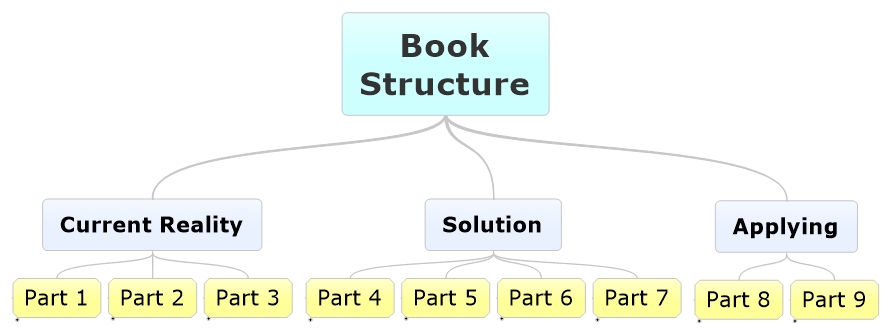Dear All
In this post, we want to ask you, our readers and those who have enjoyed this blog site, to help us with a title for this upcoming book. We already have a contract with a publisher and have a couple of titles in mind but need your help.
The book addresses a methodological approach for managing projects. We have published many articles on this approach on this site.
I will list below the structure and high-level outline of the book.
Structure and Outline
The following image presents the high-level structure of the book, which has three major sections, consisting of nine parts, and fifty-one chapters.

First Section
The first section represents the current reality of the project management practice. It consists of three parts:
- Part 1 presents the global project management scene with a focus on project management professional associations and various definitions that are necessary for the rest of the book.
- Part 2 is dedicated to project management standards and the state of current practice. There is an emphasis on ISO 21500 and PMBOK® Guide as references that are highly popular in the project management community. These two guides share a similar structure, in particular, the process groups, processes, and functions. However, this section also addresses other standards, namely from GPM® Global and IPMA®.
- Part 3 highlights the challenges in the current practice of project management, especially as they relate to the leading standard documents. This part clarifies some gaps, opportunities, confusion between process groups and project phases versus the project life cycle. It also covers some of the gaps and inconsistencies in these popular resources.
Second Section
The second section presents The Solution, a methodological approach and is the core section of the book. It consists of four parts.
- Part 4 presents an overview of the proposed solution, which includes topics such as the necessity to have an organizational project management system. Further, this part introduces the three-dimensional model, its fundamental concepts, and the rationale behind it. The presented model is The Customizable and Adaptable Methodology for Managing Projects™, CAMMP™.
- Part 5 shift the focus and go into the details of the first dimension. This dimension is about the concept of a project life cycle, spanning a project from the idea to closure. It includes a discussion of the phases, stages, stage deliverables, and stage gates. There is a dedicated chapter for each of the project stages of the standard CAMMP™ Model.
- Part 6 highlights the second dimension, which is the project management processes and functions. This part includes the links to global standards and guides, along with a new perspective on project planning and the need to split management planning from detailed (product’s oriented) planning. Further, this part includes two chapters dedicated to content not covered in the PMI and ISO guides; such as two additional subject areas and numerous additional processes. These are essential topics, which would enable the reader to understand the guides and CAMMP™, fully, and without any ambiguity.
- Part 7 is dedicated to the third dimension and includes topics that should overlay the first two dimensions. These would be the subjects that would help organizations reach a higher level of project management maturity. The chapters cover these topics: competence, sustainability, and best practices.
Third Section
The last section of the book covers discussions for applying the methodological approach in the real world and under different conditions; it consists of two parts.
- Part 8 is titled ‘Managing the Three Dimensions’ since it elaborates and offers topics that help the practitioners visualize the link between the dimensions and how to apply them. These include the following concepts: approvals, estimating, control, change and risk management, the people aspects (teams and stakeholders), and project success.
- Part 9 is also about tailoring the CAMMP™ concepts to real world scenarios with chapters covering project classifications, project owner versus service provider perspectives, customizing the model to industries or organizations, adapting the model to functions or project types, potential pitfalls, and a few simulated samples. This part also includes a closing chapter.
Possible Titles
- As we wrote this book, we had chosen a long title, which is Managing Projects, a Three-Dimensional Model
- Another option was Flexible Project Management
- Another possibility suggested is Flexible and Disciplined Project Management
- A variation on the previous title is Flexible and Stringent Project Management
- An old title we used was Redefining the Basics of Project Management but since this is more advanced then Redefining Project Management
- Managing Projects; End-to-end
- Maybe a bold title: PM Beyond Agile and Waterfall
- Holistic Project Management
- Total Project Management (from Total Quality Management)
- Project Management in 3D: a new way to look at the project life cycle
- PM3D: A New Way to Look at the Project Lifecycle
- Alternates to 10 and 11 are 3D Project Management or 3D PM
- PM the Missing Dimension(s)
- Project Management for the 21st Century
- Variation on 7: Next Generation (or = Holistic) PM; A Multidimensional Model Beyond Agile, Waterfall, and Certification
- Project Management, Redefined
Some keywords about the book and methodology
- It covers project end to end
- It incorporates the learning from global associations (PMI, ISO, IPMA, GPM, CII, GAPPS …)
- It integrates a project life cycle model with the process groups
- It incorporates best practices, competence, and sustainability
- It includes a model for project success and emphasizes benefits management
- It is a tailored approach – customizable and adaptable (flexible)
- A core element is stage and process gates (discipline)
- It offers major changes to the process groups, knowledge areas and other established concepts (Redefining)
So What do you think? The winner of the chosen title will be acknowledged in the book 🙂 Select one of the above or suggest an alternate title.
[contact-form][contact-field label=’Name’ type=’name’/][contact-field label=’Email’ type=’email’/][contact-field label=’Website’ type=’url’/][contact-field label=’Title’ type=’text’ required=’1’/][contact-field label=’Reasons for Title’ type=’textarea’/][/contact-form]
